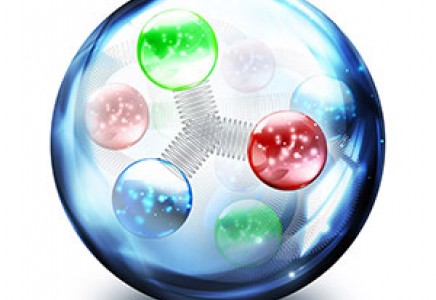
An Electron Ion-Collider could allow for a better understanding of the particles that make up our visible universe, including the quarks (red, green and blue small spheres) and gluons (connecting springs) inside the proton and neutron.
The Electron-Ion Collider is considered to be essential to the United States’ ability to contribute to world-leading scientific research. Researchers hope such a machine can help answer fundamental questions about ordinary matter, revealing for the first time and in detail how matter’s smallest building blocks and nature’s universal forces combine to build our visible universe.
To explore the infinitesimal, nuclear and particle physicists rely on particle accelerators. These machines serve as microscopes for the very heart of matter, where protons and neutrons combine to form the nucleus of the atom, and where quarks and gluons come together to build protons and neutrons. The Electron-Ion Collider is a powerful and precise tool that will enable both the discovery of new particles and the further exploration of known particles and forces that constitute visible matter.
A polarized Electron-Ion Collider, such as the machine being proposed for Jefferson Lab, would be uniquely suited to address several outstanding questions of the theory that describes the basic building blocks of matter, Quantum Chromodynamics (QCD). QCD is a framework for understanding how the building blocks of protons and neutrons, called quarks, are bound together by the “strong force.” The strong force is one of the four forces of nature – along with gravity, the electromagnetic and weak forces – and it is the force that builds protons and neutrons and the nuclei of atoms.
When scientists probe the heart of matter, they’re exploring a veritable zoo of tiny particles that combine to form the familiar atoms that make up all visible matter, from your favorite pair of jeans, to the planet we stand on, to the stars in the sky. These explorations often center on the nucleus of the atom and its protons and neutrons. Each proton and neutron is primarily made from three particles called quarks. These quarks are bound together by the exchange of other particles called gluons, which carry the strong force.
In fact, quarks are bound together so strongly, that no quark has ever been found in isolation, but only ever as a constituent particle bound up with another quark or quarks. One of the goals of Jefferson Lab’s newly upgraded Continuous Electron Beam Accelerator Facility is to discover and probe particles that can reveal more about how the strong force binds quarks together. The upgraded CEBAF, which would become a part of Jefferson Lab’s proposed EIC, is on track to probe a particle in which the gluons are enhanced in such a way that experimenters can probe those gluons, and the strong force, in detail never before accessible by experimenters. An EIC could then continue the study of gluons with even greater precision, and may even be capable of probing gluons directly.
An EIC could also allow for a better understanding of ordinary protons and neutrons. For instance, the complete mapping of these particles’ three-dimensional structure, a long-time goal of nuclear physicists. It’s also expected that an EIC could provide insights into all particles built of quarks, called hadrons, something no other machine is currently capable of providing. An EIC could potentially reveal in detail how quarks and gluons are distributed inside hadrons, how quarks and gluons move inside hadrons, what role quarks interactions have with themselves and the strong-force gluons, and how the intrinsic spin and movement of the quarks and gluons contribute to the spin of hadrons.
Further, this detailed mapping could finally reveal how transient particles contribute to the structure of protons and neutrons. These transient, so-called “sea particles” are quarks and gluons that continuously blink into and out of existence inside hadrons. An EIC could reveal, for the first time, the role this quark-gluon sea plays in the microscopic structure of protons and neutrons.
Finally, an EIC could help scientists understand why matter behaves the way it does at all levels of view, from a scattered collection of quarks and gluons, to a hadron built of quarks and gluons, to the nucleus of the atom built of hadrons.
In the end, it’s hoped that the insights made possible by an Electron-Ion Collider could ultimately lead to the discovery of how the ordinary matter that we see today first coalesced from a morass of quarks and gluons in the early universe and how quarks and gluons and protons and neutrons underpin the fabric of our visible universe today.


